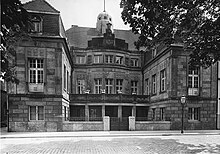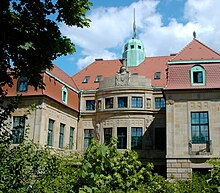Corps Saxonia Hanover
The Corps Saxonia Hannover is a corps in the Weinheim Seniors' Convent (WSC). The corps is obligatory and colored . It brings together students and former students from Hanover's universities and technical colleges. The corps members are called Saxen .
Color
Saxonia wears the colors green-white-black with silver percussion . The foxes wear the colors black-white-black with silver percussion. The coat of arms of Saxonia shows a crossing with the Saxon heads in the red field at the top left, the white Saxon eagle in the blue field at the bottom right, as well as the ribbon and the club cross with wreath and date of foundation in the other two fields. In the middle there is a second, smaller shield , which shows the compass and the Saxon diamond .
history
The corps was founded on February 27, 1852 by the engineer Harry Bock von Wülfingen (1829–1881) together with other members of the "Polytechnic Singing Association Hanover" (PGV) and is a founding member of the Weinheim Senior Citizens' Convent (WSC). Bock von Wülfingen was director of Hannoversche Maschinenbau AG ( Hanomag ) and had previously founded the PGV as a student corporation. Wilhelm Kleinschmidt (1831–1890), also a PGV member, was Saxonia's first senior .
On March 31, 1852 Saxonia joined the SC in Hanover. On February 27, 1856, members of Saxonia Hannover donated the later cartel corps Saxonia Karlsruhe under the same colors, the same circle motto, the same motto and a common coat of arms . On February 6, 1857, both corps signed a cartel agreement . The Saxenkartel still exists today and is the oldest in the WSC. On January 9, 1863, Saxonia donated the Corps Teutonia Hanover . On April 7, 1863, Saxonia was one of the founding corps of the WSC. The third corps founded by Saxonia was the foundation of the Corps Saxonia Danzig on October 18, 1904, with which it merged on February 27, 1922, after it had already been suspended on April 2, 1912.
Today's corp house at Wilhelm-Busch-Strasse 16 ( Nordstadt ) was built in 1912 according to plans by Hermann Schaedtler and has, among other things, a ballroom and twelve student rooms.
After the self-dissolution of the Corps on October 27, 1935, forced by the National Socialists, Saxonia reconstituted on June 21, 1949 at the Technical University of Hanover.
Corps Saxonia Danzig
On October 18, 1904, twelve days after the inauguration of the Technical University of Danzig , three Saxonia Hanover corps boys donated the Corps Saxonia Danzig in the Hotel Danziger Hof on the initiative of Aute Bode . The corps received the same colors and hats, the same coat of arms, the same motto and slogan as the mother corps. The compass was changed slightly by adding a small additional line. The statutes were also adopted with only a few changes. The bell hammer was introduced as a student fencing weapon .
After the first scales had been fought outside Danzig in the SC zu Berlin (WSC) , at the end of the first semester a pounding relationship could be concluded with the free hammering connection Borussia, the later Corps Borussia . In February 1905, Saxonia became a member of the Saxenkartel. On May 4, 1905, it met with the Corps Baltica, which had opened two days earlier, for the Danzig Seniors' Convention .
Saxonia enjoyed a great reputation at the university, was well established in Gdansk society and was favored by the authorities. Friendly relations were cultivated with the officer corps of the 2nd West Prussian Field Artillery Regiment No. 36 . Even naval officers who were to train temporarily at the TH Danzig, were among the frequent guests of the Corps.
In the summer semester of 1912 there was a serious saber claim by an active member of Saxonia against another student and the claimant assaulted the claimant, as a result of which the Saxon was granted the consilium abeundi and the Corps Saxonia was suspended from the university for one year. The incident, which had legal consequences, was also picked up in the press by the Anti-Duel League . After the suspension imposed by the authorities had expired, Saxonia was unable to return it and was merged into Saxonia Hannover on February 27, 1922.
Corps Teutonia Hanover
A first Corps Teutonia was founded in November 1851 at the Polytechnic School in Hanover , which was approved by the rector in February 1852 as a colored compound. On February 25, this Teutonia merged with the striking connection Visurgia to form a senior citizens' convention , which the Corps Saxonia joined on March 31, 1852. From June 5, 1852 until the beginning of the winter semester 1852/53, Teutonia was dissolved by the board of directors. On October 8, 1853, Teutonia dissolved itself after the rector had asked the members for permission from their parents to become active. The inventory was handed over to Saxonia.
On January 9, 1863, the second Corps Teutonia Hannover was founded by 6 members of Saxonia Hannover. The inventory of the first Teutonia, which had been handed over to Saxonia in 1853, was taken over. However, the newly established corps is not considered a continuation of the old Teutonia. Immediately after it was founded, Teutonia and Saxonia renewed the Hanover Seniors 'Convent, which was recognized by telegram from the Karlsruhe Seniors' Convent. A few weeks later the members of the Association of Livonians joined Teutonia.
On April 7, 1863 in Frankfurt am Main, Teutonia was one of the ten founding corps of the General Seniors 'Convent (ASC), later the Weinheim Seniors' Convent (WSC). The coat of arms with the colors green-white-red and the circle of Teutonia is still to this day on the coat of arms gate of the Wachenburg , it is the second coat of arms from the left in the lower middle row.
The development in the following years was unsteady, the corps had to temporarily cease active operations, from the end of the winter semester 1867/68 to the beginning of the summer semester 1868, from the end of November 1870 to October 1871 and from February 1, 1878 to April 4 1878. After disputes between members of Teutonia and a member of the Corps Alemannia had arisen between members of the Teutonia and a member of the Corps Alemannia on the occasion of the celebration of the unsuccessful assassination attempt by Max Hödel on Kaiser Wilhelm I in 1878 , the Hanoverian senior citizens -Convent on Teutonia pronounced the so-called mild SC disrepute (exclusion) for an indefinite period. This exclusion was later lifted and restricted to the individuals involved. At the end of 1879, however, Teutonia finally had to cease active operations. The old rulers continued to exist until the Weinheim Senior Citizens' Convention was dissolved in 1935 and was closely associated with the Corps Saxonia Hannover.
Known members
- Johann Peter Blank (1925–2014), President of the Federal Railway Central Office in Minden, Chairman of the Weinheim Association of Old Corps Students
- Harry Bock von Wülfingen (1829–1881), mechanical engineer
- Aute Bode (1846–1921), building contractor, chief engineer, founder of the Weinheim Association of Old Corps Students , father of the Wachenburg
- Georg Bokelberg (1842–1902), civil engineer, architect, city planning officer and railway worker
- Hermann Wilhelm Bödeker (1799–1875), Protestant pastor in Hanover
- Gustav Brüninghaus (1875–1955), steel industrialist
- Ernst Bühring (1844–1928), architect
- Fritz Clarfeld (1886–1935), industrialist and politician
- Gerrit van Delden (1842–1925), chemist and textile industrialist
- Hendrik van Delden (1872–1950), owner of cotton spinning and twisting mills
- Gustav Fusch (1871–1943), mechanical engineer
- Wilhelm Germelmann (1850–1919), civil engineer for hydraulic engineering, coastal and port construction
- Alfred Gröbler (1865–1926), coal and steel industrialist
- Franz Haniel junior (1842–1916), entrepreneur in the coal and steel industry
- Hans-Dieter Harig (* 1938), industrial manager, CEO of EON Energie AG
- Friedrich Heeren (1803–1885), Privy Councilor and Professor
- Werner Kümmel (1834-1893), civil engineer
- Christian Kuhlemann (1891–1964), engineer, entrepreneur and politician, honorary citizen and honorary senator of the University of Hanover
- Georg Lasius (1835–1928), architect and university professor
- Hans-Joachim Liesecke (1931–2019), professor for green space construction at the University of Hanover
- Wilhelm Lüer (1834–1870), architect
- Hansheinrich Meier-Peter (* 1939), professor of marine engineering, marine engineering and marine technology
- Theodor Mithoff (1835-1892), high school teacher, university professor for economics and parliamentarian
- Heinrich Ranafier (1846–1930), railway engineer, secret senior building officer
- Franz von der Recke (1854–1923), Minister of State
- Moritz Rühlmann (1811–1896), mathematician and mechanical engineer and honorary citizen of the city of Hanover
- Hermann Schaedtler (1857–1931), architect, delivered a. a. the design for the corp house of Saxonia in Wilhelm-Busch-Straße
- Ernst Schiess (1840–1915), industrialist, founder of the Association of German Machine Tool Builders
- Gerhard Stoffert (* 1926), professor of horticulture and horticultural economics
- Leo Sympher (1854–1922), civil engineer
- Ferdinand Wallbrecht (1840–1905), architect, building contractor and national liberal politician
- Oskar Wolff (1858–1943), industrialist, honorary citizen of the city of Walsrode
- Wulfdiether Zippel (* 1938), economist, professor for international economic relations at the Technical University of Munich (1980-?)
See also
literature
- Michael Doeberl u. a. (Ed.): Das akademische Deutschland , Volume 2: The German universities and their academic citizens , Berlin 1931, p. 836.
- History of the Corps Saxonia up to the 50th year of its existence (1852–1902) , Göhmannsche Buchdruckerei u. Publishing bookstore, Hanover 1902.
- History of the Corps Saxonia from 50. – 100. Years of its existence (1902-1952) , Alois Wolpers printing works, Hanover 1955.
- History of the Corps Saxonia from 100-150. Years of its existence (1952-2002) , Hannover 2008
- The Corps of the WSC and the local SC . In: Handbook for the Weinheim Senior Citizens' Convention . Chapter 1.1.4., 1971.
- Paulgerhard Gladen: The Kösener and Weinheimer Corps: Your representation in individual chronicles . 1st edition. WJK-Verlag, Hilden 2007, ISBN 978-3-933892-24-9 , pp. 278-279, 290 .
- Paulgerhard Gladen : History of the student corporation associations , Volume 1, pp. 49–51, Würzburg 1981.
- Hans Schüler: Weinheimer SC-Chronik , Darmstadt 1927, pp. 276–353.
Individual evidence
- ^ Ernst Hans Eberhard : Handbook of the student liaison system. Leipzig, 1924/25, p. 137.
- ↑ Bernhard Schroeter: For Burschenschaft und Vaterland , 2006, page 168/169 ( digitized version )
- ^ Hermann Schaedtler at Architekt.de
- ↑ Hans Schüler: Weinheimer SC-Chronik , Darmstadt 1927, p. 579f.
Web links
- Official homepage of the Corps Saxonia Hannover
- Collection of color cards of the Corps Saxonia Hannover , accessed on December 6, 2015
- Im Fuchsbau from the Hannoversche Allgemeine Zeitung of October 5, 2013, accessed on February 26, 2015





